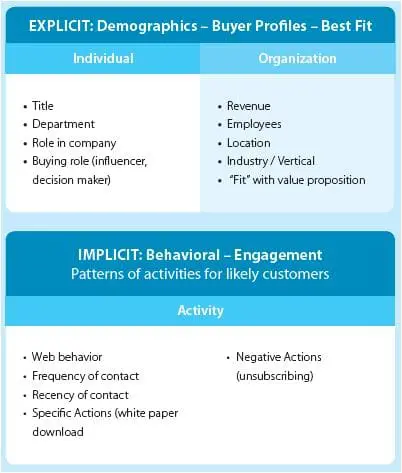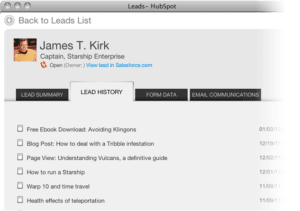 Inbound marketing can help you attract high volumes of leads — but how do you separate the good quality leads from the people who are just starting to look around? That’s where lead management, and specifically lead scoring, comes in. With lead scoring, you can attach values to each of your leads based on their professional information and the behavior they’ve exhibited on your website.
Inbound marketing can help you attract high volumes of leads — but how do you separate the good quality leads from the people who are just starting to look around? That’s where lead management, and specifically lead scoring, comes in. With lead scoring, you can attach values to each of your leads based on their professional information and the behavior they’ve exhibited on your website.
Does your business even need lead scoring?
First and foremost, you need to evaluate whether your business is one that would actually benefit from a lead scoring system. The fact is, it’s not a must-have for every business, and in many cases, scoring leads can actually be a waste of your time. To evaluate whether lead scoring is right for your business, ask yourself the following questions:
- Is my sales team getting fed with enough leads? If your sales team
doesn’t even have enough leads to begin with, lead scoring is hardly necessary. Instead, your marketing team should be focusing on generating more leads. - Does my sales team even call the leads I do send them? Furthermore, do they always complain about bad leads? Lead scoring would probably solve these problems, right? Maybe not. What’s more likely in this situation is that you have a sales/marketing alignment issue on your hands. If your business doesn’t have a service level agreement (SLA) in place between your sales and marketing teams to clarify how many leads marketing must deliver to sales and how many sales must follow up with, sit down together and create one before you even think about lead scoring.
- Do I have enough data to implement lead scoring? In order to implement a lead scoring system, you need to have two types of data in place: demographic information captured by conversion forms, and lead intelligence, or behavioral data based on how a lead interacts with your website. Are you collecting the wrong information from your lead gen forms, or failing to track how leads interact with your site using an analytics and lead management platform? Then you don’t have the right data to start lead scoring.
If you can answer “yes” to all three of these questions, then there’s a good chance your business could benefit from lead scoring, and you should read on.
Best practices for setting up lead scoring
It’s important to understand that there are two different dimensions for lead scoring, implicit and explicit. Implicit lead scoring is based on behavior and engagement, factors such as web behavior, frequency of contact, and specific action. Explicit lead scoring is reflective of demographics and buyer personas.

For many companies that could use lead scoring, the simplest way to set this up is to focus on implicit behavior and engagement first, and then adjust for demographics and personas.
Easy example of lead scoring best practices – implicit behavior
Let’s setup a basic lead scoring system that looks at 5 website activities: page views, visits, form submissions, emails opened, and email click-through rate. These five behavioral metrics are easy to obtain and understand, and can provide a solid beginning for a lead scoring system. (If you’re using HubSpot, you can find the Custom Lead Scoring at Contacts->Contact Settings, in the left menu.)
Pageviews: Let’s say that up to and including 5 page views is worth 5 points, and that each succeeding block of 5 page views is worth another 5 points. So our rules for lead scoring would look like this:
| Pageviews | <= 5 | 6-10 | 11-15 | 15-20 | 20+ |
| Lead score | 5 | 10 | 15 | 20 | 25 |
Visits: We might say the the number of visits to our site is more important that the number of pageviews, so we’ll score this behavior a little differently.
| Visits | 1 | 2 | 3 | 4 | 5 | 6 | 7 | 8 | 9 | 10 |
| Lead score | 10 | 20 | 30 | 40 | 50 | 60 | 70 | 80 | 90 | 100 |
Forms: Filling out a form on our website is even more important, so our lead scoring will be weighted
more heavily for this activity:
| Forms submitted | 1 | 2 | 3 | 4 | 5 | 6 | 7 | 8 | 9 | 10 |
| Lead score | 20 | 40 | 60 | 80 | 100 | 120 | 140 | 160 | 180 | 200 |
Emails Opened: We love it when people open our emails – let’s assign 10 points for each opened email.
| Emails Opened | 1 | 2 | 3 | 4 | 5 | 6 | 7 | 8 | 9 | 10 |
| Lead score | 10 | 20 | 30 | 40 | 50 | 60 | 70 | 80 | 90 | 100 |
Email Click-thru: Email opens are good — but email clicks are even better. Our email clicks are worth 20 points each.
| Email Clicks | 1 | 2 | 3 | 4 | 5 | 6 | 7 | 8 | 9 | 10 |
| Lead score | 20 | 40 | 60 | 80 | 100 | 120 | 140 | 160 | 180 | 200 |
With only five metrics, we’ve developed the basis for a sound lead scoring system. Now let’s look at how to enhance it.
Lead scoring best practices – explicit factors
Now sit down with Sales to determine the explicit factors you want to include in your lead scoring system. You may want to assign points for job title or role in the company, for geographic location, for industry “fit”, or for number of employees. Which of these are more likely to be a buying criteria? How many points should these factors have? This is all information you can gather from your conversion forms on the website.
Next, look at behaviors that indicate a lead’s type of interest. Here, you’ll need to use your lead intelligence data to conduct some analysis with closed-loop analytics to identify the close rates of each of the conversion events you offer on your website. Next, compare the close rates with one another. You’ll want to identify which conversion events had the highest close rates as well as which activities led to those conversion events. Here’s a sampling of the different criteria you should evaluate.
 Types of Interest:
Types of Interest:
- Requested a demo or specific information
- Viewed a certain type of product page
- Top-of-the funnel interests (e.g. content downloads like ebooks and webinars) vs. more qualified middle-of-the-funnel interests (e.g. product content like pricing pages or a free trial)
Putting it all together
Apply this scoring system to all your customers and prospects. . . everyone. Why include customers? They will give you the very best information about what factors (implicit and explicit) best lead to a sale.
Once everyone is scored, it’s time to figure out what a marketing-qualified lead (MQL) and a sales-qualified Lead (SQL) are. Take an arbitrary slice off the top, let’s say a score of over 200 points, and see how big that list is in relation to your total list. Review some of the contacts on this list with Sales and determine if they are SQLs. Adjust the cut-off point as needed so that you can agree on the numeric definition of a sales-ready lead.
In the same way, you can define a numeric value for a marketing-qualified lead. You might be surprised about how many prospects are in each category!
Final tips for lead scoring optimization
This certainly isn’t the only way to set up a lead scoring system, but we’ve found it to be an easy way that is readily understandable for most people. Here are some tips to make the lead scoring process go smoothly, and to align with Sales and their experience.
- The actual lead score isn’t the main objective — what matters is the hierarchy of point values (some activities are worth more than others) so that the higher the score, the more actionable the lead.
- A lower score doesn’t equate to a “bad lead” — it usually indicates an early stage in the buying journey. Based on the score and nurturing rules, the lead may be a likely candidate for email nurturing.
- Continuous scoring improvement is a must, analyzing scoring algorithms against actual sales outcomes, and validating with sales team input and other data sources.
- Work with Sales to agree on which metrics to use to evaluate the effectiveness of the lead scoring system, and where to make adjustments.
- Review visitor online behavior to see if their actions are really demonstrating the best leads and are being reflected properly in the scores.
- Consider including attributes for “negative” behaviors, such as non-product web page visits, unsubscribing from email lists, requesting ‘do not contact’, etc.
It’s important to remember that, because a lead’s activity can change from day to day, a lead’s individual score will also change over time. For this reason, lead scoring isn’t something easily done manually. As mentioned above, you’ll need lead management software that enables you to set your lead scoring criteria and auto-score and re-score your leads in real time. Depending on your CRM, you could then set up alerts based on your custom lead score to notify your sales team when leads have reached that critical score that makes them sales-ready.
Has your business implemented a lead scoring system? How has it improved your marketing and sales processes?
Thanks to Doug Kirk for the basic lead scoring system!




